I still remember the worried look on my Grandfather’s face, standing at the edge of our parched field in Azamgarh, looking at the sky for a sign of rain that never came.
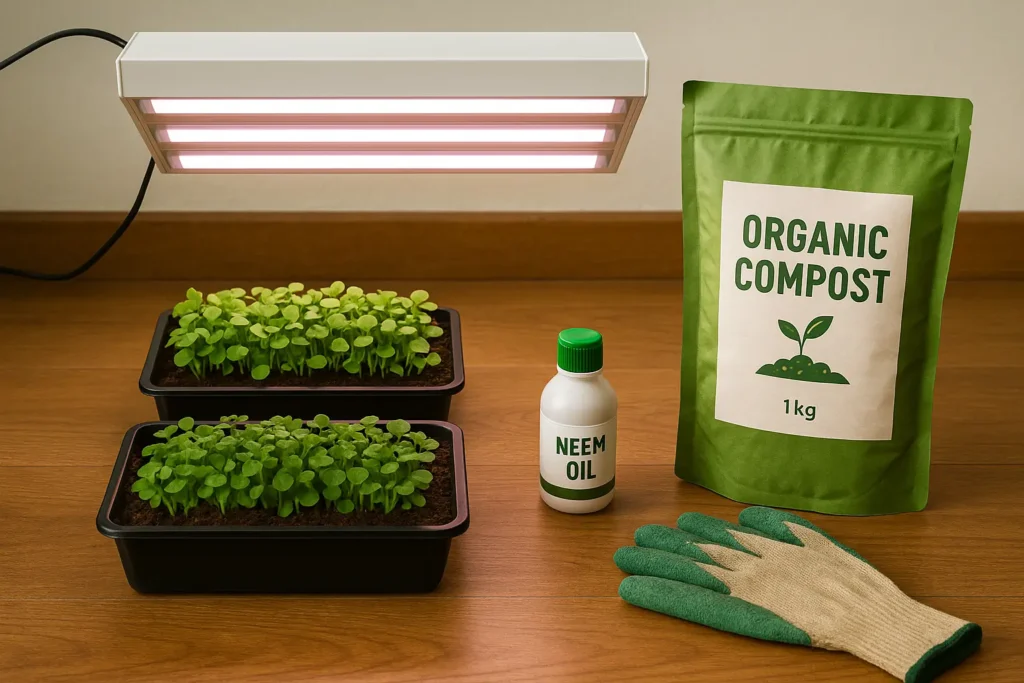
For generations, we Indian farmers have trusted the sky, the soil, the seasons. But what happens when that trust is broken by unseasonal rains, scorching heat, and rising costs of fertilizers and diesel?
The search for a reliable answer led me from the fields of Punjab to the books of my agriculture degree, and finally to a solution that feels like a promise: how to start indoor farming. This is not just about growing plants in a room; it’s about taking back control.
This article is my sincere attempt to share that knowledge with you, my fellow farmers and agri-enthusiasts.
If you are new to the concept, start with our Beginner’s Guide to Home Vertical Farming.”
Indoor vs. Outdoor vs. Rooftop Farming: Choosing Your Battlefield
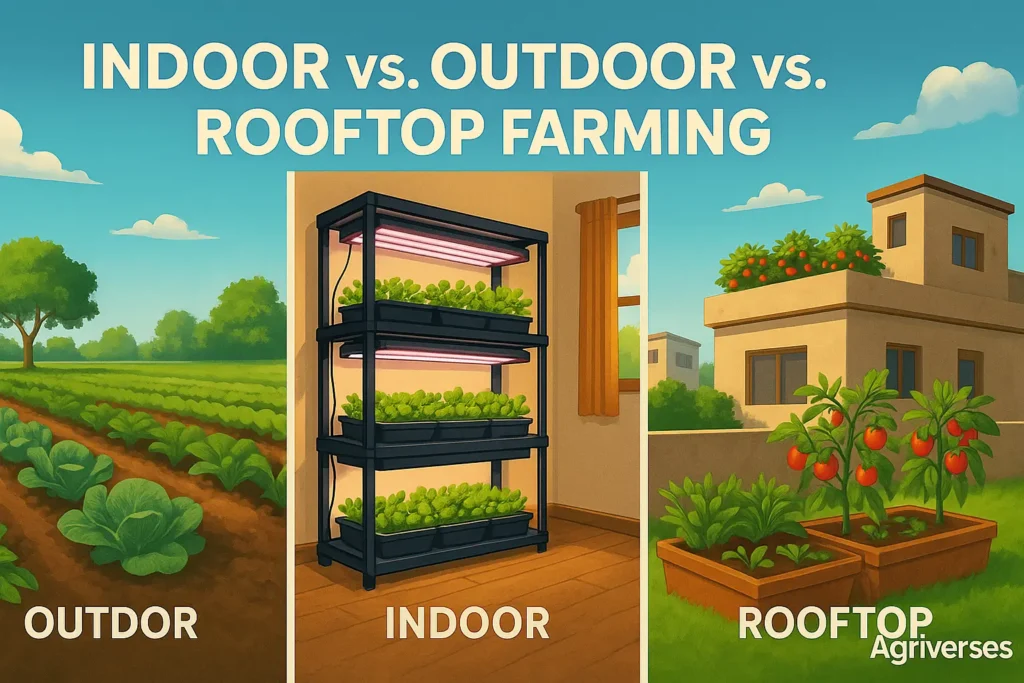
Before we dive deep, let’s understand the ground we are standing on. For a farmer, land is everything. But in this new age, the definition of ‘land‘ is changing.
Traditional Outdoor Farming:
This is our legacy, our parampara. It’s the rhythm of sowing and harvesting under the open sky. We know its strengths – the sheer scale, the connection with Mother Earth. But we also know its pains intimately: dependency on the monsoon, the constant battle with pests and diseases, and the uncertainty of the market.
Rooftop Farming:
Many of us in towns and cities have started using our terraces. This is a fantastic middle path! It uses forgotten space, gets ample sunlight, and can provide fresh vegetables for the family or a small local market. However, it’s still partially exposed to the whims of nature – a sudden hailstorm or a pest infestation from a neighbouring tree can wipe out your hard work.
Indoor Farming:
Now, imagine this. A farm where there are no seasons. Where rain, hail, or scorching sun cannot touch your crops. Where you, not nature, decide the exact amount of light, water, and nutrients your plants get. That is the power of indoor farming.
It is a controlled environment, a sanctuary for your crops. It means you can grow high-value crops year-round, regardless of what’s happening outside. The initial investment might seem like a hurdle, but the control and consistency it offers are revolutionary. For a smallholder, this is not just farming; it’s a planned, predictable business.
While outdoor and rooftop farming still rely on natural conditions, indoor vertical farming at home lets you create your own micro-climate. This is especially important for organic growers who need pest-free, controlled environments.
Want to build your own setup? Check our Step-by-Step Guide.
Best Crops for Indoor Vertical Farming
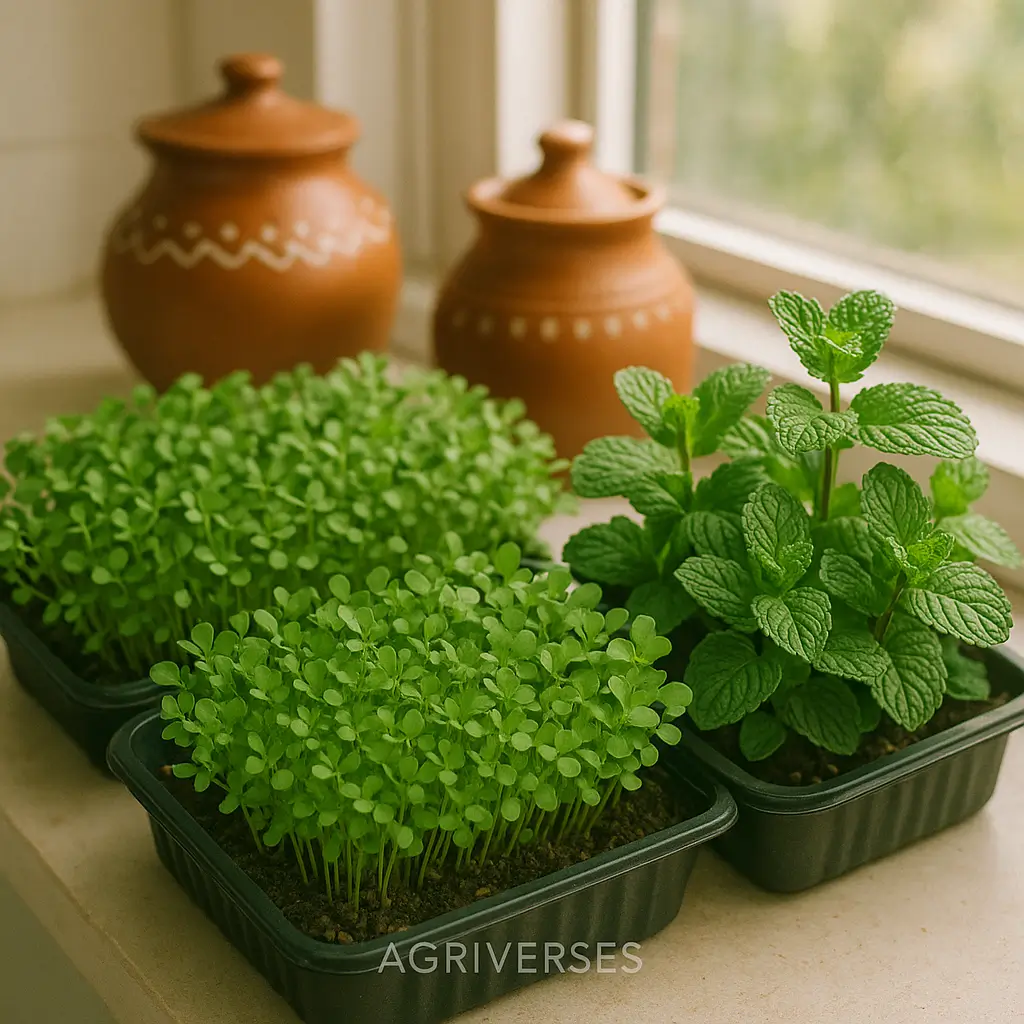
When you have a controlled environment, you must be smart about what you grow. We’re not growing sugarcane or wheat indoors! We need crops that are quick, high-value, and perfectly suited for compact spaces. This is the core strategy of how to start indoor farming successfully.Here are the heroes of the indoor farm:
1. Microgreens – Fastest Organic Returns
These are not sprouts, nor are they full-grown plants. Microgreens are the young seedlings of vegetables and herbs, harvested just after the first true leaves have developed. Think of them as the baby version of radish (mooli), mustard (sarson), coriander (dhaniya), broccoli, or fennel (saunf).
- Why they are brilliant: They are the definition of “chota packet, bada dhamaka” (small package, big explosion). They grow incredibly fast, often ready to harvest in just 10-15 days. Their nutritional value is concentrated, and they fetch a premium price in urban markets, especially from high-end restaurants and health-conscious consumers. For a farmer looking for quick, rotating cash flow, microgreens are a blessing.
2. Herbs – Everyday Value
HerbsThink about the constant demand for fresh coriander, mint (pudina), basil (tulsi), and lemongrass in every Indian kitchen. Now imagine supplying these herbs fresh, year-round, without a speck of dust or pesticide residue on them.
- The indoor advantage: Herbs like these are delicate. Outdoors, heavy rain can bruise them, and pests love them. Indoors, they thrive. You can grow them in vertical stacks, one on top of the other, multiplying your growing area without needing more land. The quality is so superior that you can market them as premium organic produce.
3. Leafy Greens – Daily Freshness.
Palak (spinach), lettuce, kale, and other leafy greens are staples. However, many farmers I’ve met complain about the number of pesticide sprays needed to get a clean harvest. The residue is a major concern for consumers.
- A clean, green solution: Indoor vertical farming at home or on a commercial scale eliminates the need for chemical pesticides. Because the environment is closed and controlled, pest attacks are rare. You can grow the cleanest, healthiest leafy greens, which is a massive selling point. The leaves are tender, clean, and ready to eat, something the market is willing to pay more for.
Remember, in indoor vertical farming at home, you’re not aiming to feed a village — you’re nurturing health and self-reliance in your kitchen.
If you can follow this guide: Top 10 Organic Vegetables to Grow on a Balcony
Organic Growing Conditions Inside a Room
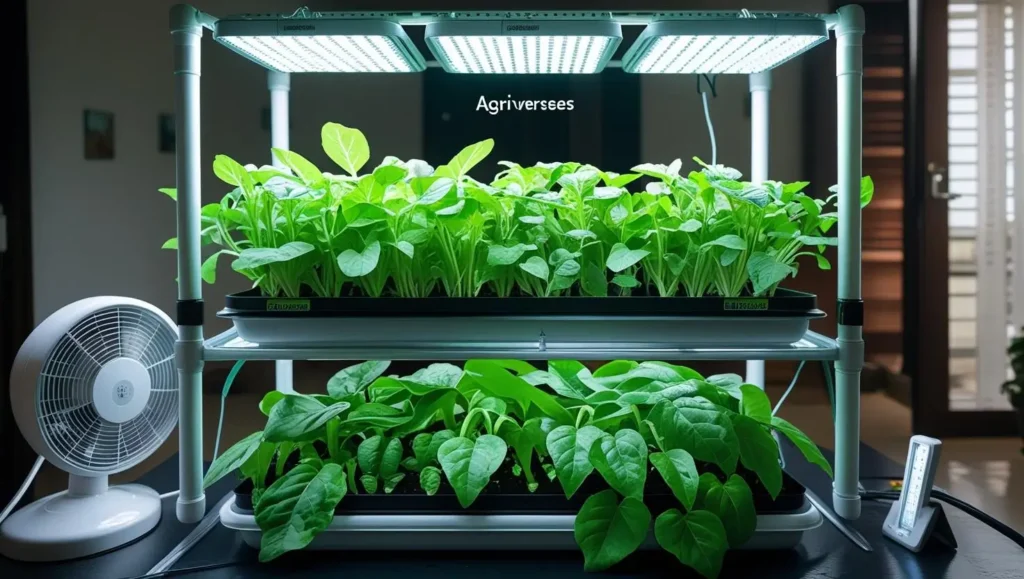
Growing indoors is not as simple as putting a pot on your table. Plants are living beings — they need proper conditions.
1. Light: The Source of Life:
Your plants need light to perform photosynthesis, the process of making food. Indoors, we replace the sun with artificial ‘grow lights’. But not just any light will do. Plants need a specific spectrum of light, primarily red and blue wavelengths. This is called Photosynthetically Active Radiation (PAR). LED grow lights are the best choice today. They are energy-efficient, produce very little heat, and you can buy panels that provide the exact light spectrum your crops need. You’ll need to run them for 12-16 hours a day, mimicking a long summer day.
2. Humidity & Temperature (The Comfort Zone):
Every plant has a happy place. Most leafy greens and herbs thrive in temperatures between 18°C and 24°C and relative humidity of 50-70%. You can monitor this using a simple digital hygrometer. To control it, you might use a humidifier or dehumidifier. Maintaining this sweet spot prevents fungal diseases like powdery mildew, a common headache in outdoor farms.
3. Air Flow (The Gentle Breeze):
In an enclosed space, the air can become stagnant. This is dangerous. It can lead to fungal growth and weak plants. A simple oscillating fan, like the one in our homes, can work wonders. It needs to be gentle, just enough to make the plant leaves tremble slightly. This strengthens the stems, improves pollination (if needed), and keeps the air fresh.
4. Natural Pest Repellents for Indoors:
The beauty of indoor farming is that you start in a clean, pest-free environment. Prevention is key.
- Neem Oil Solution: The go-to solution for any organic farmer. A diluted spray of neem oil every 15 days on your plants can deter most common pests.
- Sticky Traps: Yellow and blue sticky traps are excellent for catching flying insects like aphids and whiteflies that might sneak in.
- Cleanliness is Godliness: Always keep your indoor farm clean. Remove any dead leaves or plant matter immediately. This gives pests no place to hide or breed.
Indoor does not mean synthetic. Organic conditions matter even more when there’s no natural ecosystem to support plant health.
Scientific Side: How Do Plants Grow Organically Indoors?
When we talk about how to start indoor farming the right way, it means understanding what’s happening biologically.
Plants absorb light through chlorophyll to make food (photosynthesis). Indoors, LED lights provide photons (light particles) similar to the sun. In soil, microbes like Azotobacter and Trichoderma help break down organic matter into absorbable nutrients.
When you farm organically, you’re feeding these microbes, not just the plant. Use liquid jeevamrut or compost tea every 15 days to maintain this balance. Good microbes help with disease resistance, faster growth, and tastier produce.
So even in a small shelf near your window, you’re creating a full living cycle.
Organic Hydroponics vs. Soil-based Indoor Farming
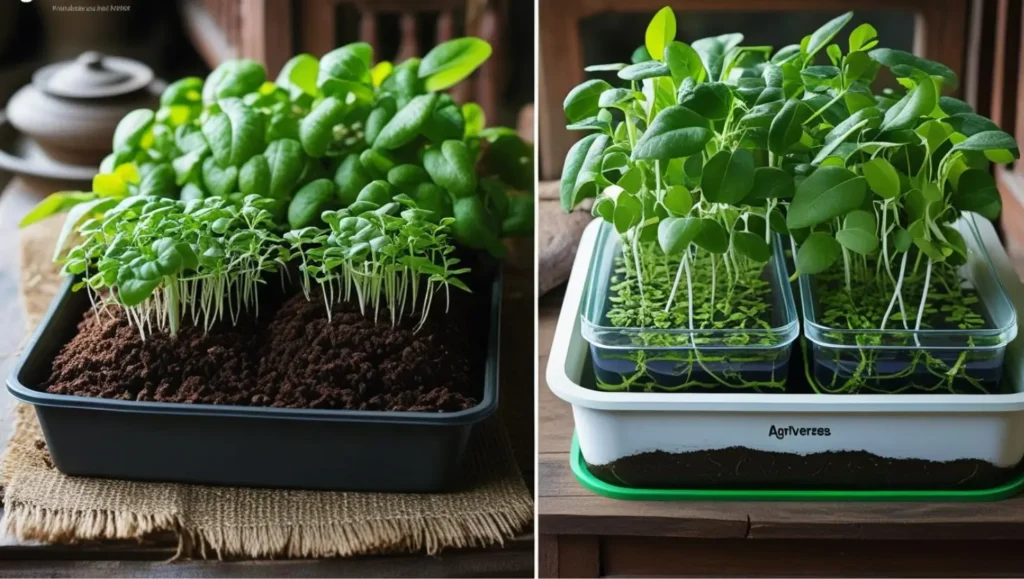
Many urban growers ask, “Should I go for hydroponics?”
Hydroponics means growing plants in water with nutrients. But doing it organically is tricky. Most commercial hydroponic nutrients are synthetic.
If you want to stay truly organic:
- Use soil or cocopeat-based systems.
- Or, in hydroponics, try DIY organic solutions like fermented banana peel water, compost tea, or panchagavya. But remember, managing pH and nutrient balance is harder.
Soil gives a buffer, supports microbes, and is more forgiving. For beginners learning how to start indoor farming, soil is simpler, cheaper, and more natural.
Maintaining Organic Certification Indoors
Planning to sell your produce? Then certification matters.
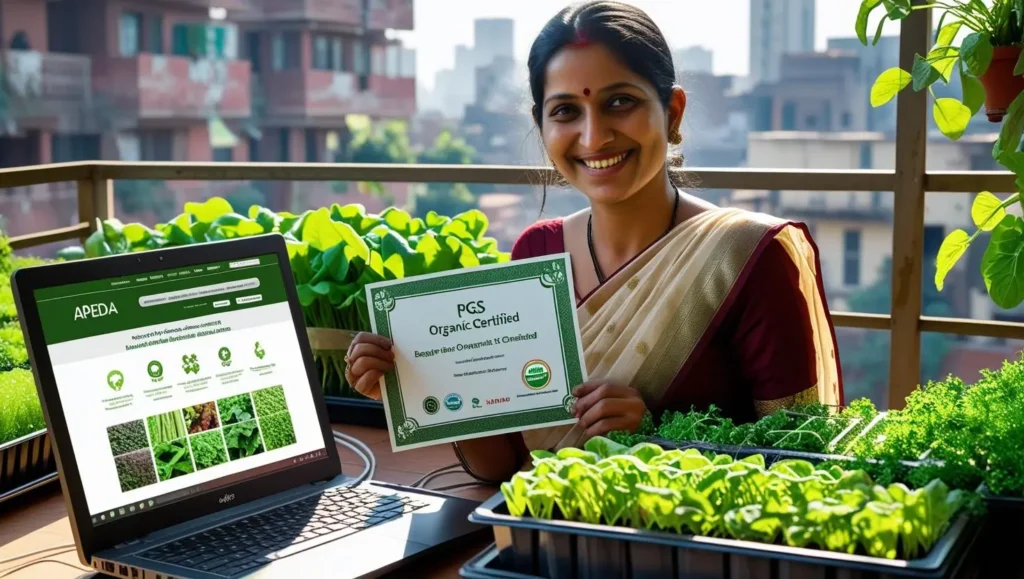
In India, the Participatory Guarantee System (PGS-India) under NCOF allows small-scale organic growers to self-certify with group networks.
Steps:
- Maintain records: inputs used, growing conditions, harvest logs.
- Use only PGS-approved organic inputs.
- Join a local organic farmer group or contact your KVK (Krishi Vigyan Kendra).
Remember, transparency is key. Even if you’re growing on a 2×2 ft rack, what matters is the purity of your practice.
Useful link: PGS India Official Portal
What’s Next for Indian Farmers?
Imagine this: a tribal woman in Bastar grows organic tulsi in recycled bottles by her window and sells herbal tea to Bangalore customers via Instagram.
Or a retired teacher in Lucknow harvests fresh spinach every 10 days in his balcony and teaches neighbours how to set up indoor grow racks.
Indoor vertical farming at home is not just about plants — it’s a silent revolution.
It’s giving people back their power to grow, eat, and earn with dignity. It’s climate-proof, cost-efficient, and deeply satisfying.
In the long run, this can:
- Reduce pressure on land
- Cut food transportation emissions
- Make organic food more accessible
- Empower women and youth in non-farming spaces
Conclusion: Start Small, Grow Wise
So, how to start indoor farming organically?
Simple. Begin with what you have. A window ledge, a grow light, a handful of soil, and a dream.
Organic indoor farming is not a tech gimmick — it’s ancient wisdom adapted to modern homes. Whether you’re a college student, a homemaker, or a village school teacher, your hands can grow clean food anywhere.
Take that first step today. Sow a seed. Light it up. Water it with love.
See how vertical farming thrives even in urban apartments in our Urban Vertical Farming article.
If This Inspired You…
Share this article with someone who’s been thinking about growing their own food. Or send it to a school group, a women’s SHG, or an urban kitchen garden club.
Want more such practical, heartfelt guidance? Explore our Organic Farming series at Agriverses.
A Greener, Smarter Rural Future
Farming isn’t just for those who own acres. It’s for every Indian who wants to reclaim their food and health.
Indoor organic farming is the future of decentralised, people-led agriculture. It connects science with sustainability. It turns idle homes into green factories.
And most importantly — it puts the power of food production back in our own hands.
Let’s build that future, one seed at a time.
Jai Kisan, Jai Vigyan.

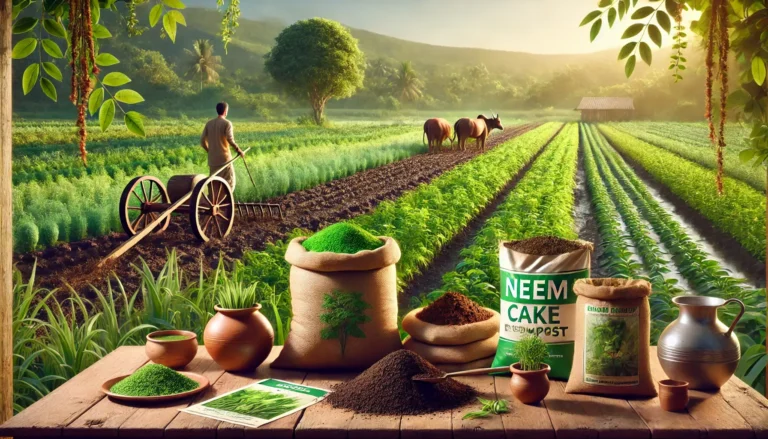
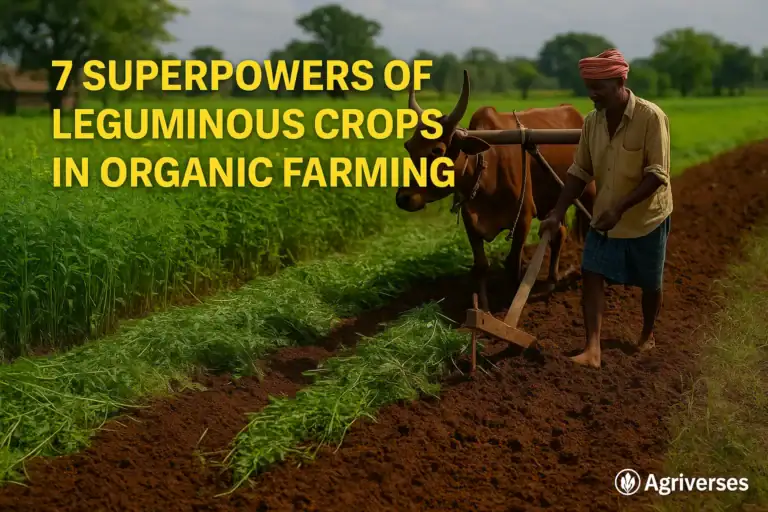


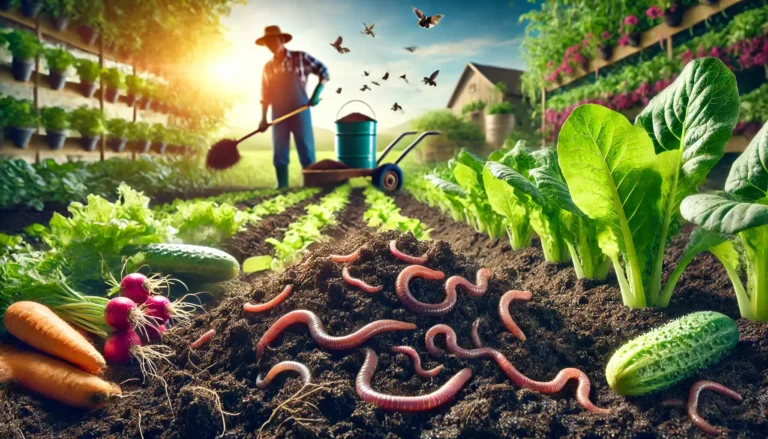

One Comment